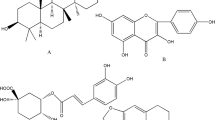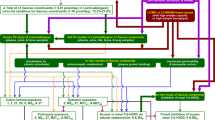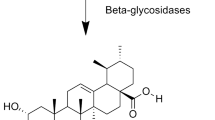Abstract
Background and objective:
Hesperetin and naringenin, the aglycones of the flavanone glycosides hesperidin and naringin, occur naturally in citrus fruits. They exert interesting pharmacological properties such as antioxidant, anti-inflammatory, blood lipid and cholesterol lowering and are considered to contribute to health benefits in humans. However, no information is available on the pharmacokinetics of the citrus flavanones hesperetin and naringenin after their oral administration to humans as pure aglycones. Therefore, the objective of the present investigation was the evaluation of the pharmacokinetic parameters of hesperetin and naringenin in plasma and urine, after their single oral administration in humans in the form of solid dispersion capsules, and also to improve the absorption rate of flavanones by using aglycones rather than the naturally occurring glycosides.
Design:
Six healthy volunteers received orally 135 mg of each compound, hesperetin and naringenin, under fasting conditions. Blood samples were collected at 14 different time points over a 12 h period. Urine was collected over 24 h, in five sequential timed intervals. Plasma and urine hesperetin and naringenin concentrations, after enzymatic hydrolysis of their conjugated forms, were measured using validated high-pressure liquid chromatography methods. Pharmacokinetic parameters for hesperetin and naringenin, such as Cmax, Tmax, AUC0−t, AUC0−∞, CL/F, V/F, t1/2, MRT, Ae, Ae(0–24), and Rmax were calculated from their plasma or urine concentrations.
Results:
Pharmacokinetic analysis showed that both hesperetin and naringenin were rapidly absorbed and their concentrations in plasma observed 20 min after dosing and reached a peak in 4.0 and 3.5 h, respectively. The mean peak plasma concentration (Cmax) for hesperetin and naringenin were 825.78±410.63 ng/ml (2731.8±1358.4 nmol/l) and 2009.51±770.82 ng/ml (7386.6±2833.4 nmol/l), respectively and the mean AUC0−∞ values were 4846.20±1675.99 ng h/ml and 9424.52±2960.52 ng h/ml for hesperetin and naringenin, respectively. The elimination half-life for hesperetin was found to be 3.05±0.91 h and for naringenin 2.31±0.40 h, respectively. The mean values of the relative cumulative urinary excretion, as percentage of the administered dose, for hesperetin and naringenin, were found to be 3.26±0.44 and 5.81±0.81%, respectively.
Conclusions:
Oral administration of the flavanone aglycones, hesperetin and naringenin, lead to their rapid absorption as their conjugated forms. The cumulative urinary recovery data indicated low bioavailability for both flavanone aglycones, owing to extensive first-pass metabolism partly by cleavage of the C-ring by the enzymes of intestinal bacteria leading to degradation products such as phenolic acids.
This is a preview of subscription content, access via your institution
Access options
Subscribe to this journal
Receive 12 print issues and online access
$259.00 per year
only $21.58 per issue
Buy this article
- Purchase on Springer Link
- Instant access to full article PDF
Prices may be subject to local taxes which are calculated during checkout


Similar content being viewed by others
References
Ameer B, Weintraub RA, Johnson JV, Yost RA, Rouseff RL (1996). Flavanone absorption after naringin, hesperidin, and citrus administration. Clin Pharmacol Ther 60, 34–40.
Berkarda B, Koyuncu H, Soybir G, Baykut F (1998). Inhibitory effect of hesperidin on tumour initiation and promotion in mouse skin. Res Exp Med (Berlin) 98, 93–99.
Bok SH, Lee SH, Park YB, Bae KH, Son KH, Jeong TS et al. (1999). Plasma and hepatic cholesterol and hepatic activities of 3-hydroxy-3-methyl-CoA reductase and acyl CoA: cholesterol transferase are lower in rats fed citrus peel extract or a mixture of citrus bioflavonoids. J Nutr 129, 1182–1185.
Bokkenheuser VD, Shackleton CH, Winter J (1987). Hydrolysis of dietary flavonoids glycosides by strains of intestinal bacteroides from humans. Biochem J 248, 953–956.
Booth AN, Jones FT, De Eds F (1958). Metabolic and glucosuria studies on naringin and phloridizin. J Biol Chem 233, 280–282.
Choudhury R, Chowrimootoo G, Stal K, Debnam E, Rice-Evans CA (1999). Interactions of the flavonoids naringenin in the gastrointestinal tract and the influence of glycosylation. Biochem Biophys Res Commun 265, 410–415.
Crespo ME, Galvez J, Cruz T, Ocete MA, Zarzuelo A (1999). Anti-inflammatory activity of diosmin and hesperidin in rat colitis induced by TNBS. Planta Med 65, 651–653.
Erlund I, Meririnne E, Alfthan G, Aro A (2001). Plasma kinetics and urinary excretion of the flavanones naringenin and hesperetin in humans after ingestion of orange juice and grapefruit juice. J Nutr 131, 235–241.
Felgines C, Texler O, Morand C, Manach C, Scalbert A, Regerat F et al. (2000). Bioavailability of the flavanone naringenin and its glycosides in rats. Am J Physiol Gastroentest Liver Physiol 279, G1148–G1154.
Franke AA, Cooney RV, Henning SM, Custer LJ (2005). Bioavailability and antioxidant effects of orange juice components in humans. J Agric Food Chem 53, 5170–5178.
Fuhr U, Kummert AL (1995). The fate of naringin in humans: a key to grapefruit juice-drug interactions? Clin Pharmacol Ther 58, 365–573.
Gibaldi M, Perrier D (1982). Pharmacokinetics, 2nd edn. Marcel Dekker: New York.
Ghosal A, Saroh H, Thomas PE, Bush E, Moore D (1996). Inhibition and kinetics of cytochrome P450. Drug Metab Dispos 24, 940–947.
Hacket AM, Marsh I, Barrow A, Griffiths LA (1979). The biliary excretion of flavanones in the rat. Xenobiotica 9, 491–501.
Havsteen B (1983). Flavonoids, a class of natural products of high pharmacological potency. Biochem Pharmacol 32, 1141–1148.
Hollman PCH, Bijsman MNCP, van Gameren Y, Cnossen EP, de Vries JH, Katan MB (1999). The sugar moiety is a major determinant of the absorption of dietary flavonoids glycosides in man. Free Rad Res 31, 569–573.
Ishii K, Furuta T, Kasuya Y (2000). Mass spectrometric identification and high-performance liquid chromatographic determination of a flavonoids glycoside naringin in human urine. J Agric Food Chem 48, 56–59.
Jang IS, Kim DH (1996). Purification and characterization of alpha-L-rhamnosidase JK-6, a hyman intestinal bacterium. Biol Pharm Bull 19, 1546–1549.
Joshipura KJ, Ascherio A, Manson JE, Stampfer MJ, Rimm EB, Speizer FE et al. (1999). Fruit and vegetable intake in relation to risk of ischemic stroke. JAMA 282, 1233–1239.
Kanaze FI, Gabrieli C, Kokkalou E, Georgarakis M, Niopas I (2003). Simultaneous reversed-phase high-performance liquid chromatographic method for the determination of diosmin, hesperidin and naringin in different citrus fruit juices and pharmaceutical formulations. J Pharm Biomed Anal 33, 243–249.
Kanaze FI, Kokkalou E, Georgarakis M, Niopas I (2004a). A validated high performance liquid chromatographic method utilizing solid-phase extraction for the simultaneous determination of naringenin and hesperetin in human plasma. J Chromatogr B 801, 363–367.
Kanaze FI, Kokkalou E, Georgarakis M, Niopas I (2004b). A validated solid-phase extraction HPLC method for the simultaneous determination of the citrus flavanone aglycones hesperetin and naringenin in urine. J Pharm Biomed Anal 36, 175–181.
Kanaze FI, Kokkalou E, Niopas I, Georgarakis M, Stergiou A, Bikiaris D (2006a). Thermal analysis study of flavonoid solid dispersions having enhanced solubility. J Therm Anal Cal 83, 283–290.
Kanaze FI, Kokkalou E, Niopas I, Georgarakis M, Stergiou A, Bikiaris D (2006b). Dissolution enhancement of flavonoids by solid dispersions in PVP and PEG matrices. A comparative study. J Appl Polym Sci 102, 460–471.
Kim DH, Jung EA, Sohng IS, Han JA, Kim TH, Han MJ (1998). Intestinal bacterial metabolism of flavonoids and its relation to some biological activities. Arch Pharm Res 21, 17–23.
Lee SH, Park YB, Bae KH, Bok SH, Kwon YK, Lee ES et al. (1999). Cholesterol-lowering activity of naringenin via inhibition of 3-hydroxy-3-methylglutaryl coenzyme A reductase and acyl coenzyme A:cholesterol acyltransferase in rats. Ann Nutr Metab 43, 173–180.
Lee YS, Reidenberg MM (1998). A method for measuring naringenin in biological fluids and its disposition from grapefruit juice by man. Pharmacology 56, 314–317.
Manach C, Morand C, Gil-Izquierdo A, Bouteloup-Demange C, Remesy C (2003). Bioavailability in humans of the flavanones hesperidin and narirutin after the ingestion of two doses of orange juice. Eur J Clin Nutr 57, 235–242.
Miyake Y, Yamamoto K, Tsujihara N, Osawa T (1998). Protective effects of lemon flavonoids on oxidative stress in diabetic rats. Lipids 33, 689–695.
Montforte MT, Trovato A, Kirjavainen S, Forestieri AM, Galati EM, Lo Cutro RB (1995). Biological effects of hesperidin a citrus flavonoid hypolipidemic activity on experimental hypercholesterolemia in rat. Il Farmaco 50, 595–599.
Nielsen ILF, Chee WSS, Poulsen L, Offord-Cavin E, Rasmussen SE, Frederiksen H et al. (2006). Bioavailability is improved by enzymatic modification of the citrus flavonoid hesperidin in humans: a randomized, double-blind, crossover trial. J Nutr 136, 404–408.
Rice-Evans C, Miller NG, Paganga G (1996). Structure antioxidant activity relationships of flavonoids and phenolic acids. Free Rad Biol Med 20, 833–956.
Rouseff RL, Martin SF, Youtsey CO (1987). Quantitative survey of narirutin, naringin, hesperidin, and neohesperidin in citrus. J Agric Food Chem 35, 1027–1030.
Rowland M, Tozer TN (1995). Clinical Pharmacokinetics: Concepts and Applications, 3rd edn. Lea & Febiger: Baltimore.
Santos KF, Oliveira TT, Nagem TJ, Pinto AS, Oliveira MG (1999). Hypolipidaemic effects of naringenin, rutin, nicotinic acid and their associations. Pharmacol Res 40, 493–496.
Tanaka T, Makita H, Kawabata K, Mori H, Kakumoto M, Satoh K et al. (1997). Chemoprevention of azoxymethane-induced rat colon carcinogenesis by the naturally occurring flavonoids, diosmin and hesperidin. Carcinogenesis 18, 957–965.
Yang M, Tanaka T, Hirose Y, Deguchi T, Mon H, Kawada Y (1997). Chemopreventive effects of diosmin and hesperidin on n-butyl-n-(4-hydroxybutyl)nitrosamine induced urinary bladder carcinogenesis in male ICR mice. Int J Cancer 73, 719–724.
Author information
Authors and Affiliations
Corresponding author
Rights and permissions
About this article
Cite this article
Kanaze, F., Bounartzi, M., Georgarakis, M. et al. Pharmacokinetics of the citrus flavanone aglycones hesperetin and naringenin after single oral administration in human subjects. Eur J Clin Nutr 61, 472–477 (2007). https://doi.org/10.1038/sj.ejcn.1602543
Received:
Revised:
Accepted:
Published:
Issue Date:
DOI: https://doi.org/10.1038/sj.ejcn.1602543
Keywords
This article is cited by
-
Effect of hesperetin on the pharmacokinetics of metoprolol succinate in rats
Future Journal of Pharmaceutical Sciences (2023)
-
A Minor Groove Binder with Significant Cytotoxicity on Human Lung Cancer Cells: The Potential of Hesperetin Functionalised Silver Nanoparticles
Journal of Fluorescence (2023)
-
Flavonoid delivery by solid dispersion: a systematic review
Phytochemistry Reviews (2022)
-
Effects of naringenin supplementation in overweight/obese patients with non-alcoholic fatty liver disease: study protocol for a randomized double-blind clinical trial
Trials (2021)
-
Synthesis and Characterization of Naringenin-Loaded Chitosan-Dextran Sulfate Nanocarrier
Journal of Pharmaceutical Innovation (2021)



